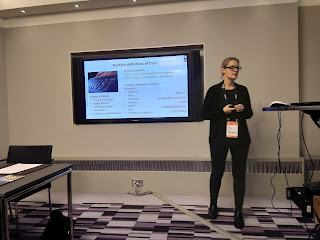From the session on data driven education, with great EU links and projects.
Carlos Delgado Kloos: using analytics in education
Opportunities
Khan academy system is
a proven system, with one of the best visualisations of how the students are
advancing. With a lot of stats and graphs. Carlos used this approach for their
0 courses (courses on basic knowledge that students must know before moving on
in higher ed).
Based on the Khan
stats, they built a high level analytics system.
Predictions in MOOCs
(see paper of Kloos), focusing on drop-out.
Monitoring in SPOCs
(small private online courses)
Measurement of Real
Workload of the students, the tool adapts the workload to the reality.
FlipApp (to gamify
flipped classroom), remember and to notify the students that they need to see
the videos before class, or they will not be able to follow. (Inge: sent to Barbara).
Creation of
Educational Material using Google classroom. Google classroom sometimes knows
what the answer of a quiz will be, which can save time for the teacher.
Learning analytics to
improve teacher content delivery.
Use of IRT (Item Response
Theory) to see which quizzes are more useful and effective, interesting to
select quizzes.
Coursera define
skills, match it to the jobs and based on that recommend courses.
Industry 4.0 (big
data, AI…) for industry, can be transferred to Education 4.0 (learning
analytics based on machine learning). (Education3.0 is using the cloud, where
both learners and teachers go to).
Machine learning
infers the rules from getting answers which are data analysed (in comparison to
computer learning, which is just the opposite, based on rules, giving answers).
Dangers:
Correlations: correlations
are not necessary correct conclusions. (see spurious correlations for fun
links).
Bias: e.g. decisions
for giving credit based on redlining and weblining.
Decisions for
recruitment: eg. Amazon recruits that the automation of their recruiting system
resulted in a biase leading to recruiting more men than women.
Decisions in trials:
eg. Compas is used by judges to calculate repeat offenders, but color of skin
was a clear bias in this program.
Decisions in academia:
Cathy O’Neil: weapons of Math Destruction – how big data increases inequalityand threatens democracy”.
Chinese social credit system
which gives minor points if you do something that is seen as not being ‘proper’.
Also combined with facial recognition, and monitoring attention in class
(Hangzhou number 11 high school).
Monitoring (gaggle, …)
Challenges
Luca challenge:
responsible use of AI.
GDPR Art 22: automated
individual decision-making, including profiling.
Sheilaproject.eu : identifying
policies to adopt learning analytics. Bit.ly/sheilaMOOC is the course on the
project.
Atoms and bits
comparison. As with atoms you can use it for the better, or for the worse (like
atomic bombs).
Maren Scheffel on Getting the trust into
trusted learning analytics @m_a_s_c
(Welten Institute of
Open University, Netherlands)
Learning analytics:
Siemens (2011) definition still the norm. But nowadays it is a lot about
analytics, but only little about learning.
Trust: currently we
believe that something is reliable, the truth, or ability. Multiple definitions
of trust, it is multidimensional and multidisciplinary construct. Luhmanndefined trust as a way to cope with risk, complexity, and a lack of system understanding.
For Luhmann the concept of trust compensates for insufficient capabilities for
fully understanding the complexity of the world (Luhmann, 1979, trust and …)
For these reasons we must be transparent,
reliable, and be integer to attract the trust of learners. There should not be
a black box, but it should be a transparent box with algorithms (transparent
indicators, open algorithms, full access to data, knowing who accesses your
data).
Policies: see https://sheilaproject.eu
User involvement and
co-creation: see the competen-SEA project see http://competen-sea.eu capacity
building projects for remote areas or sensitive learner groups. One of the
outcomes was to co-design to create MOOCs (and trust) getting all the
stakeholders together in order to come to an end product. MOOCs for people, by
people. Twitter #competenSEA

No comments:
Post a Comment